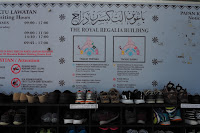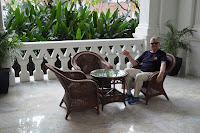 |
| The infamous Chinese egg tart |
This understandable addiction resulted in Mr. Patten earning the unfortunate moniker of “fatty patty”, the calorie count off the scale.
We’ve had the good fortune to visit Hong Kong a number of
times over the years, this stay a stopover on our way to Bali. On this particular visit we had planned a foodie
walking tour of the lesser known haunts of Hong Kong Island.
 |
| Interesting wares line the sidewalk |
Ascending from the depths of the metro station concourse, we emerged into blinding sun and an assault of aromatic smells.
The hustle and bustle on Des Voeux Road was
evident with delivery trucks disgorging all sorts of goods without care for the
hoi polloi on the sidewalks. Fish hung
on the railings alongside the curb, their scales glinting in the
sunlight. Merchants showcased their
exotic wares, containers and cotton sacks spilling over on to the pavement. Picking one’s path through this assault
required extreme concentration, and a full stomach!
Satisfied that we had the drill organized for the next day
we returned to the MTR, visiting the magnificent Marks and Spencer food floor,
the Melton Mowbray pies absolutely outstanding.
Another hop on the MTR took us over to
Kowloon on the other side of Victoria Harbour and a sentimental visit to “the
Pen”, one of the best hotel experiences we have ever enjoyed (last visit). Afternoon tea was in full swing as the
quartet on the Juliet balcony overlooking the Peninsula’s cavernous lobby played
their hearts out.
No stay in Hong Kong is complete without a ride on Star Ferries, it never disappoints. Returning to Hong Kong Island our feet were barking. Time to rest up.
No stay in Hong Kong is complete without a ride on Star Ferries, it never disappoints. Returning to Hong Kong Island our feet were barking. Time to rest up.
Next morning we met up with Richard, our foodie guide for
the day. A small group of nine made
introductions and set out for our first stop – Dim Sum at the Lin Heung Kui Tea
House. The old restaurant heaved with
humanity, Richard guiding us to the third floor “where it was less busy”.
“Busy” must mean something different here because the third floor was stacked with people, cheek by jowl, the smiling dim sum waitresses somehow finding a way to manoeuvre their carts to each table while a grizzled server heaved an oversized steaming kettle to infuse the waiting teapots. No one was going to get in his way! Dim Sum’s OK but I’ll never be able to square with chickens feet no matter how succulent the sauce topping the skeletal remains.
 |
| We're watching |
“Busy” must mean something different here because the third floor was stacked with people, cheek by jowl, the smiling dim sum waitresses somehow finding a way to manoeuvre their carts to each table while a grizzled server heaved an oversized steaming kettle to infuse the waiting teapots. No one was going to get in his way! Dim Sum’s OK but I’ll never be able to square with chickens feet no matter how succulent the sauce topping the skeletal remains.
Waiving goodbyes to our toothless server, we ventured along
Wing Lok Street, eyeing the dried seafood, shark fins, birds’ nests, dried
caterpillars and other goods apparently essential to good health.
Two well fed cats reclined lazily on overstuffed sacks of unrecognizable goods in one store, eyeing us suspiciously. In house rat catchers perhaps.
Two well fed cats reclined lazily on overstuffed sacks of unrecognizable goods in one store, eyeing us suspiciously. In house rat catchers perhaps.
 |
| Mak's excellent wonton house |
The original restaurant was discovered by Anthony Bourdain who cited the blend of delicious broth, al dente noodles, delicate shrimp and tender beef brisket made in this kitchen, in his opinion, a required “go to”. It was. The chef dispensed the wonton with lightning speed while an associate worked feverously in the background assembling the next batch.
 |
| Milk teas all round |
Both offerings were really good. As we sipped on the beverage Richard took us up on the Central - Mid-Levels Escalator system, the world’s longest outdoor covered escalator system linking the hilly districts of Hong Kong Island high above the busy traffic.
Before heading off to the Wanchai district on the “ding
ding” – Hong Kong’s famous open air tram – we stopped at the Apothecary where a
traditional Chinese medicine practitioner dispensed his exotic wares while his
assistants carefully wrapped the prescription ingredients in rice paper.
The tram ride gave us pause to contemplate our experiences so far, but the best was yet come.
The tram ride gave us pause to contemplate our experiences so far, but the best was yet come.
 |
| A well earned Michelin star |
The Joy Hing Restaurant specializes in roasted meats and even has a Michelin star. The restaurant capacity is small and as our group of 9 was guided into a space not much bigger than a walk in closet we realized this was not a place to linger. You ate then left. Nine stools magically became available as peer pressure governed the day.
No sooner than the last morsel was consumed we left our seats, still chewing, the long line of hungry customers on the street eyeing us patiently for their turn. Despite the rush, the food was absolutely fabulous.
Our final stop was the Honolulu Coffee Shop. Apparently the owner didn’t know what to call
his establishment and settled on this.
The name did nothing to promote the delicious wares on sale, the star of
which was the egg tart. Richard served our egg tarts in a nearby park. The experience brought a whole new meaning to
“melt in the mouth”. We understood how
Mr. Patten had become addicted to this creamy confection.
Hong Kong is like that.
So much to savour. When you
discover something special it’s hard not to overindulge on the flavour!





















































